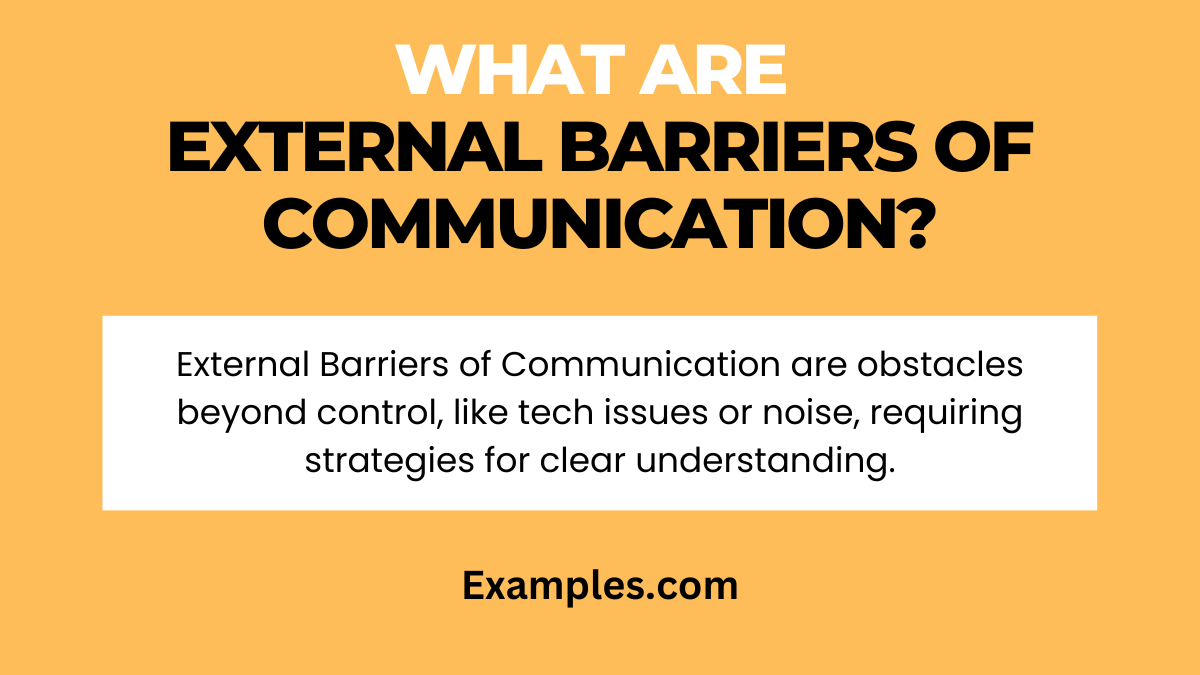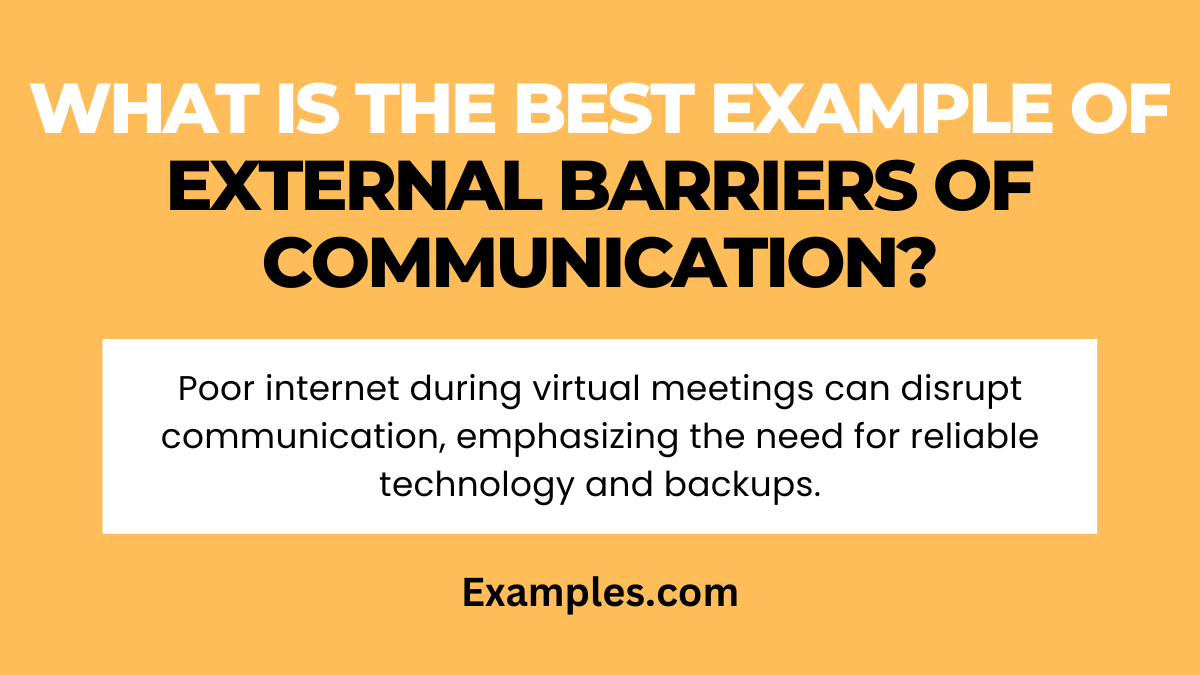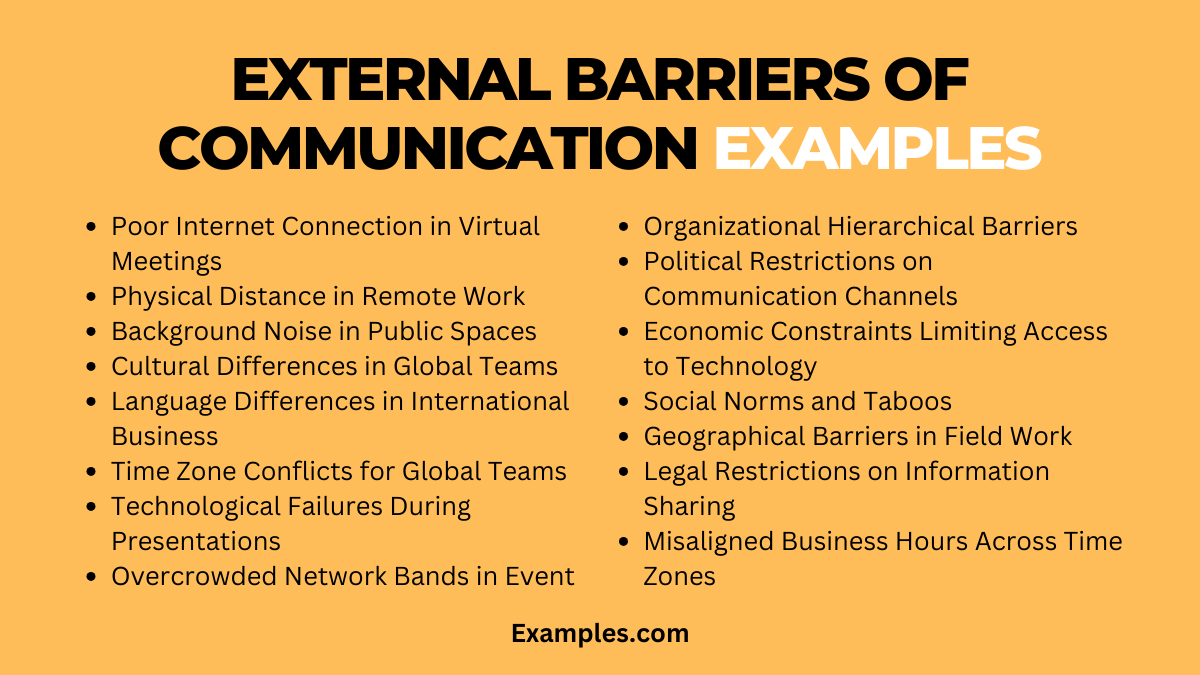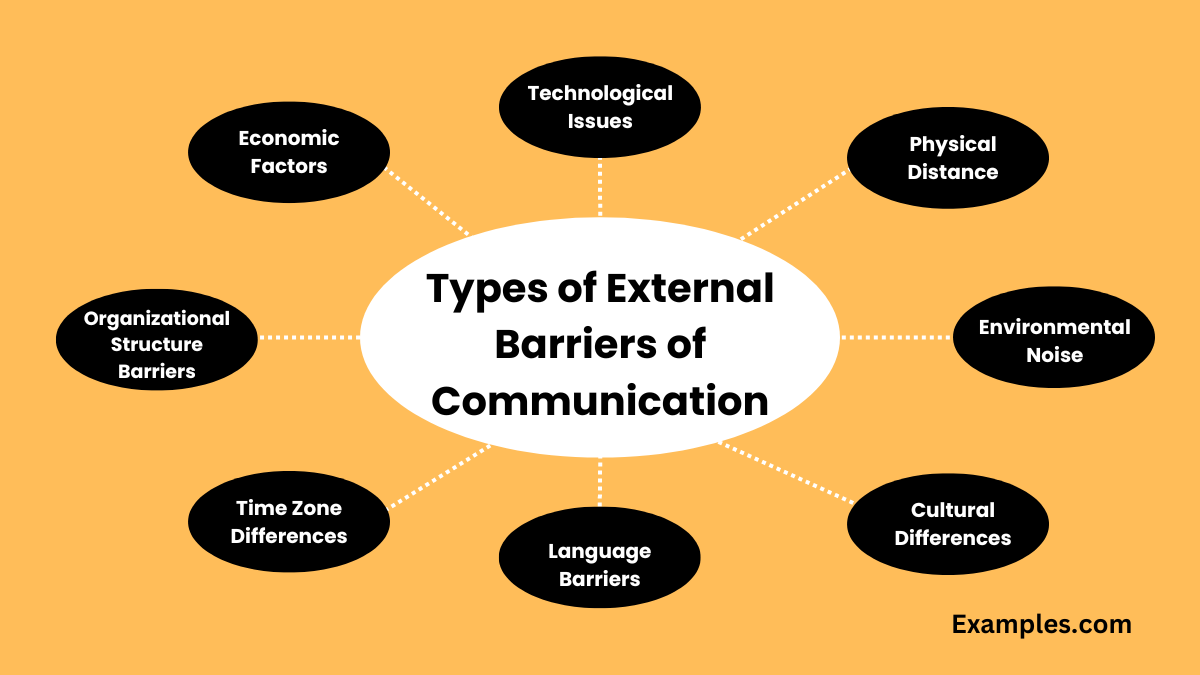19+ External barriers of Communication Examples
External Barriers of Communication are obstacles that impede the flow of information outside the control of communication participants. These barriers can range from technological issues to environmental factors, often causing delays, misunderstandings, or complete breakdowns in communication. Understanding these barriers is crucial for developing effective strategies to mitigate their impact, ensuring messages are conveyed clearly and efficiently in various settings. This overview explores the nature of external barriers and offers insights into navigating these challenges.
What are External Barriers of Communication?

External Barriers of Communication refer to the obstacles that hinder effective communication but originate outside the immediate control of the individuals involved. These can include technological disruptions, physical distance, environmental noise, and other situational factors. Such barriers often require specific strategies to be overcome or mitigated, ensuring that the intended message is successfully received and understood.
What is the Best Example of External Barriers of Communication?

A prime example of External Barriers of Communication is a poor internet connection during a virtual meeting, leading to broken speech, delayed responses, and miscommunication. This scenario highlights the need for reliable technology and backup plans to ensure uninterrupted communication, especially in settings that rely heavily on digital tools for interaction.
20 External Barriers of Communication Examples

External barriers significantly influence the effectiveness of communication. These barriers, originating from outside the immediate control of the communicators, can range from technological issues to environmental factors. Addressing these External barriers of Communication is crucial for ensuring clear and effective interactions. This guide highlights 20 unique examples of external communication barriers, each illustrating different challenges that can arise in various contexts and offering suggestions for how to navigate these obstacles effectively.
- Poor Internet Connection in Virtual Meetings: Leads to miscommunication and disrupted flow of information.
Example: “Your voice is breaking up; can we reconnect?” - Physical Distance in Remote Work: Difficulties in establishing rapport and understanding.
Example: “Let’s schedule regular video calls to bridge the distance.” - Background Noise in Public Spaces: Hinders the ability to hear and be heard clearly.
Example: “It’s quite noisy here; let’s find a quieter spot.” - Cultural Differences in Global Teams: Misinterpretations due to varying cultural norms.
Example: “Could you explain how this is typically done in your culture?” - Language Differences in International Business: Challenges in clear and precise communication.
Example: “Let’s use simpler language or a translator for clarity.” - Time Zone Conflicts for Global Teams: Difficulty in finding suitable meeting times.
Example: “Could we rotate meeting times to accommodate all time zones?” - Technological Failures During Presentations: Disruption in the flow of information.
Example: “My screen is frozen; let me try sharing again.” - Environmental Disasters Affecting Communication Infrastructure: Natural events disrupting communication channels.
Example: “Due to the storm, our phone lines are down.” - Overcrowded Network Bands in Events: Signal jamming leading to poor connectivity.
Example: “The network is congested; let’s try communicating via text.” - Organizational Hierarchical Barriers: Delays in message transmission through levels of hierarchy.
Example: “I’ll need to pass this up the chain for approval.” - Political Restrictions on Communication Channels: Government-imposed barriers affecting information flow.
Example: “Due to regulations, we can’t use this communication platform here.” - Economic Constraints Limiting Access to Technology: Inability to afford advanced communication tools.
Example: “Our budget doesn’t allow for high-end video conferencing equipment.” - Social Norms and Taboos: Certain topics being off-limits or sensitive.
Example: “Discussing this topic openly might not be appropriate here.” - Geographical Barriers in Field Work: Difficulties in communication due to remote locations.
Example: “We have limited reception in the field; let’s use satellite phones.” - Legal Restrictions on Information Sharing: Compliance issues affecting the flow of information.
Example: “We need to be mindful of data protection laws while sharing this info.” - Public Transport Noise During Calls: Inability to hear or be heard while commuting.
Example: “I’m on the train; can I call you back once I arrive?” - Misaligned Business Hours Across Time Zones: Non-overlapping working hours impeding communication.
Example: “Their office might be closed now; let’s email and wait for their response.” - Interruptions in Public Wi-Fi Services: Unreliable internet access in public areas.
Example: “The Wi-Fi here is unstable; I might lose connection.” - Climatic Conditions Affecting Signal Strength: Weather-related disturbances in communication channels.
Example: “Heavy rain is affecting our satellite connection.” - Cultural Misunderstandings in Marketing Communications: Inadvertent offenses in international marketing campaigns.
Example: “This slogan might not translate well culturally; let’s reconsider it.”
Addressing these External barriers of Communication requires careful planning, the use of appropriate technologies, and a deep understanding of the various factors that can impact communication.
Types of External Barriers of Communication

External barriers of Communication are diverse and can significantly impede the effectiveness of information exchange. These barriers occur outside of the control of the communication participants and can arise in various environments.
- Technological Issues: Interruptions due to technology failure, like poor internet connectivity.
- Physical Distance: Challenges in communicating effectively over long distances.
- Environmental Noise: Background noise that hinders auditory communication.
- Cultural Differences: Misunderstandings due to differing cultural backgrounds.
- Language Barriers: Difficulties when communicators do not share a common language.
- Time Zone Differences: Challenges in synchronizing communication across different time zones.
- Organizational Structure Barriers: Communication issues arising from complex organizational hierarchies.
- Economic Factors: Lack of resources to access advanced communication tools.
Importance of External Barriers of Communication
Understanding the Importance of External Barriers of Communication is crucial for ensuring effective information exchange, especially in diverse and dynamic environments.
- Ensures Effective Global Communication: Recognizing these barriers is key in global business operations.
- Facilitates Inclusive Dialogue: Helps in creating strategies that include diverse groups effectively.
- Improves Information Accuracy: Reduces the chance of miscommunication and misinformation.
- Enhances Efficiency: Understanding these barriers can lead to more streamlined communication processes.
- Supports Relationship Building: Overcoming these barriers aids in building trust and rapport.
- Encourages Technological Advancements: Highlights the need for better communication technology.
- Aids in Crisis Management: Essential for effective communication during emergencies.
- Promotes Cultural Understanding: Helps in navigating cultural differences in communication.
How to Overcome External Barriers of Communication
Overcoming External Barriers of Communication involves strategic planning and the use of appropriate tools and techniques to ensure clear and effective exchange of information.
- Utilize Advanced Technology: Employ reliable and advanced communication technologies.
- Implement Clear Communication Protocols: Establish well-defined communication guidelines and procedures.
- Cultural Sensitivity Training: Educate about cultural differences to avoid misunderstandings.
- Language Training and Translation Services: Use translation services or train in language skills.
- Flexible Scheduling: Accommodate different time zones for global communication.
- Streamline Organizational Communication: Simplify hierarchical structures to improve information flow.
- Invest in Quality Infrastructure: Upgrade facilities to reduce environmental noise and distractions.
- Regular Review and Adaptation: Continually assess and adapt strategies to address new barriers.
Addressing these External Barriers of Communication is key to ensuring that messages are conveyed accurately and effectively, fostering successful interactions in a variety of settings.
Effectively navigating External barriers of Communication is essential for successful information exchange in diverse settings. Recognizing and strategically addressing these barriers enhances clarity, efficiency, and inclusivity in communication. This guide serves as a valuable tool in identifying common external obstacles and offers practical strategies for overcoming them, thereby facilitating more effective and streamlined communication processes across various environments.
19+ External barriers of Communication Examples

External Barriers of Communication are obstacles that impede the flow of information outside the control of communication participants. These barriers can range from technological issues to environmental factors, often causing delays, misunderstandings, or complete breakdowns in communication. Understanding these barriers is crucial for developing effective strategies to mitigate their impact, ensuring messages are conveyed clearly and efficiently in various settings. This overview explores the nature of external barriers and offers insights into navigating these challenges.
What are External Barriers of Communication?

External Barriers of Communication refer to the obstacles that hinder effective communication but originate outside the immediate control of the individuals involved. These can include technological disruptions, physical distance, environmental noise, and other situational factors. Such barriers often require specific strategies to be overcome or mitigated, ensuring that the intended message is successfully received and understood.
What is the Best Example of External Barriers of Communication?

A prime example of External Barriers of Communication is a poor internet connection during a virtual meeting, leading to broken speech, delayed responses, and miscommunication. This scenario highlights the need for reliable technology and backup plans to ensure uninterrupted communication, especially in settings that rely heavily on digital tools for interaction.
20 External Barriers of Communication Examples

External barriers significantly influence the effectiveness of communication. These barriers, originating from outside the immediate control of the communicators, can range from technological issues to environmental factors. Addressing these External barriers of Communication is crucial for ensuring clear and effective interactions. This guide highlights 20 unique examples of external communication barriers, each illustrating different challenges that can arise in various contexts and offering suggestions for how to navigate these obstacles effectively.
Poor Internet Connection in Virtual Meetings: Leads to miscommunication and disrupted flow of information.
Example: “Your voice is breaking up; can we reconnect?”Physical Distance in Remote Work: Difficulties in establishing rapport and understanding.
Example: “Let’s schedule regular video calls to bridge the distance.”Background Noise in Public Spaces: Hinders the ability to hear and be heard clearly.
Example: “It’s quite noisy here; let’s find a quieter spot.”Cultural Differences in Global Teams: Misinterpretations due to varying cultural norms.
Example: “Could you explain how this is typically done in your culture?”Language Differences in International Business: Challenges in clear and precise communication.
Example: “Let’s use simpler language or a translator for clarity.”Time Zone Conflicts for Global Teams: Difficulty in finding suitable meeting times.
Example: “Could we rotate meeting times to accommodate all time zones?”Technological Failures During Presentations: Disruption in the flow of information.
Example: “My screen is frozen; let me try sharing again.”Environmental Disasters Affecting Communication Infrastructure: Natural events disrupting communication channels.
Example: “Due to the storm, our phone lines are down.”Overcrowded Network Bands in Events: Signal jamming leading to poor connectivity.
Example: “The network is congested; let’s try communicating via text.”Organizational Hierarchical Barriers: Delays in message transmission through levels of hierarchy.
Example: “I’ll need to pass this up the chain for approval.”Political Restrictions on Communication Channels: Government-imposed barriers affecting information flow.
Example: “Due to regulations, we can’t use this communication platform here.”Economic Constraints Limiting Access to Technology: Inability to afford advanced communication tools.
Example: “Our budget doesn’t allow for high-end video conferencing equipment.”Social Norms and Taboos: Certain topics being off-limits or sensitive.
Example: “Discussing this topic openly might not be appropriate here.”Geographical Barriers in Field Work: Difficulties in communication due to remote locations.
Example: “We have limited reception in the field; let’s use satellite phones.”Legal Restrictions on Information Sharing: Compliance issues affecting the flow of information.
Example: “We need to be mindful of data protection laws while sharing this info.”Public Transport Noise During Calls: Inability to hear or be heard while commuting.
Example: “I’m on the train; can I call you back once I arrive?”Misaligned Business Hours Across Time Zones: Non-overlapping working hours impeding communication.
Example: “Their office might be closed now; let’s email and wait for their response.”Interruptions in Public Wi-Fi Services: Unreliable internet access in public areas.
Example: “The Wi-Fi here is unstable; I might lose connection.”Climatic Conditions Affecting Signal Strength: Weather-related disturbances in communication channels.
Example: “Heavy rain is affecting our satellite connection.”Cultural Misunderstandings in Marketing Communications: Inadvertent offenses in international marketing campaigns.
Example: “This slogan might not translate well culturally; let’s reconsider it.”
Addressing these External barriers of Communication requires careful planning, the use of appropriate technologies, and a deep understanding of the various factors that can impact communication.
Types of External Barriers of Communication

External barriers of Communication are diverse and can significantly impede the effectiveness of information exchange. These barriers occur outside of the control of the communication participants and can arise in various environments.
Technological Issues: Interruptions due to technology failure, like poor internet connectivity.
Physical Distance: Challenges in communicating effectively over long distances.
Environmental Noise: Background noise that hinders auditory communication.
Cultural Differences: Misunderstandings due to differing cultural backgrounds.
Language Barriers: Difficulties when communicators do not share a common language.
Time Zone Differences: Challenges in synchronizing communication across different time zones.
Organizational Structure Barriers: Communication issues arising from complex organizational hierarchies.
Economic Factors: Lack of resources to access advanced communication tools.
Importance of External Barriers of Communication
Understanding the Importance of External Barriers of Communication is crucial for ensuring effective information exchange, especially in diverse and dynamic environments.
Ensures Effective Global Communication: Recognizing these barriers is key in global business operations.
Facilitates Inclusive Dialogue: Helps in creating strategies that include diverse groups effectively.
Improves Information Accuracy: Reduces the chance of miscommunication and misinformation.
Enhances Efficiency: Understanding these barriers can lead to more streamlined communication processes.
Supports Relationship Building: Overcoming these barriers aids in building trust and rapport.
Encourages Technological Advancements: Highlights the need for better communication technology.
Aids in Crisis Management: Essential for effective communication during emergencies.
Promotes Cultural Understanding: Helps in navigating cultural differences in communication.
How to Overcome External Barriers of Communication
Overcoming External Barriers of Communication involves strategic planning and the use of appropriate tools and techniques to ensure clear and effective exchange of information.
Utilize Advanced Technology: Employ reliable and advanced communication technologies.
Implement Clear Communication Protocols: Establish well-defined communication guidelines and procedures.
Cultural Sensitivity Training: Educate about cultural differences to avoid misunderstandings.
Language Training and Translation Services: Use translation services or train in language skills.
Flexible Scheduling: Accommodate different time zones for global communication.
Streamline Organizational Communication: Simplify hierarchical structures to improve information flow.
Invest in Quality Infrastructure: Upgrade facilities to reduce environmental noise and distractions.
Regular Review and Adaptation: Continually assess and adapt strategies to address new barriers.
Addressing these External Barriers of Communication is key to ensuring that messages are conveyed accurately and effectively, fostering successful interactions in a variety of settings.
Effectively navigating External barriers of Communication is essential for successful information exchange in diverse settings. Recognizing and strategically addressing these barriers enhances clarity, efficiency, and inclusivity in communication. This guide serves as a valuable tool in identifying common external obstacles and offers practical strategies for overcoming them, thereby facilitating more effective and streamlined communication processes across various environments.


